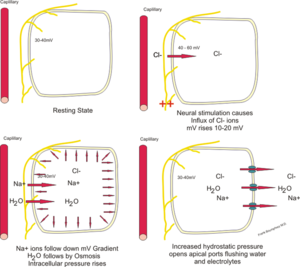Electrolyte

An electrolyte is a substance that will allow current to flow through the solution when dissolved in water. Electrolytes promote this current flow because they produce positive and negative ions when dissolved. The current flows through the solution in the form of positive ions (cations) moving toward the negative electrode and negative ion (anions) moving the positive electrode.
Electrolytes can be classified as strong electrolytes and weak electrolytes. Strong electrolytes are substances that completely break apart into ions when dissolved. The most familiar example of a strong electrolyte is table salt, sodium chloride. Most salts are strong electrolytes, as are strong acids such as hydrochloric acid, nitric acid, perchloric acid, and sulfuric acid. Strong bases such as sodium hydroxide and calcium hydroxide are also strong electrolytes. Although calcium hydroxide is only slightly soluble, all of the compound which dissolves in completely ionized.
Weak electrolytes are substances which only partially dissociate into ions when dissolved in water. Weak acids such as acetic acid, found in vinegar, and weak bases such as ammonia, found in cleaning products, are examples of weak electrolytes. Very slightly soluble salts such as mercury chloride are also sometimes classified as weak electrolytes. Ligands and their associated metal ions can be weak electrolytes.
Not all substances that dissolve in water are electrolytes. Sugar, for example, dissolves readily in water, but remains in the water as molecules, not as ions. Sugar is classified as a non-electrolyte. Water itself ionizes slightly and is a very, very weak electrolyte.
Additional topics
Science EncyclopediaScience & Philosophy: Dysprosium to Electrophoresis - Electrophoretic Theory